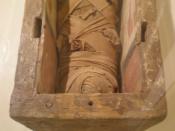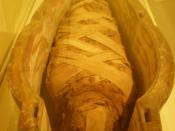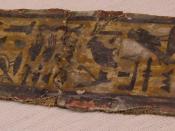In this essay I will compare and contrast two statues of different time periods. The first statue is Vajrayaksa, from the Kamakura period. This small sculpture made of wood and dates back to 1185 in Japan. The second sculpture is Iret-iruw: mummy, from the Ptolemaic period. This life-size sculpture dates back to 305 b.c.e. and is made of cartonnage and wood. Both have symbolisms of the supernatural and concepts of death and religion.
Both sculptures are painted and have great detail of the human body. Vajrayaksa is one of the five wisdom kings that protect the five wisdom buddhas. It has six arms probably representing the many tasks of the sculpture and three faces probably representing that is watched every direction. Protecting the buddhas would not have been an easy job back then. It holds a very fancy cup probably representing holiness, a wheel probably representing that you will not get away, a bow and arrow, sword, and some sort of torture device that all represent the strengths and power of it.
Iret-iruw is a mummy in a coffin and is a realistic sculpture. The coffin contains the mummified body of Iret-iruw. The mask on the mummy represents the face of Iret-iruw as he use to look the face is also painted on the outside of the coffin. His chest representation of him is also painted on the outside of the coffin. The verses on the coffin are meant to protect him from his enemies in his afterlife and also help him to come in and out of his afterlife safely. Iret-iruw died in his 30s of an ear infection that invaded his brain.
Vajrayaksa is a small sculpture standing 42.9cm high and is arms with weapons and clothed in a classic Japanese battle garment. Iret-iruw is life-size...


